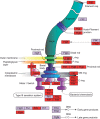Inferring functional modules of protein families with probabilistic topic models
- PMID: 21554720
- PMCID: PMC3098182
- DOI: 10.1186/1471-2105-12-141
Inferring functional modules of protein families with probabilistic topic models
Abstract
Background: Genome and metagenome studies have identified thousands of protein families whose functions are poorly understood and for which techniques for functional characterization provide only partial information. For such proteins, the genome context can give further information about their functional context.
Results: We describe a Bayesian method, based on a probabilistic topic model, which directly identifies functional modules of protein families. The method explores the co-occurrence patterns of protein families across a collection of sequence samples to infer a probabilistic model of arbitrarily-sized functional modules.
Conclusions: We show that our method identifies protein modules - some of which correspond to well-known biological processes - that are tightly interconnected with known functional interactions and are different from the interactions identified by pairwise co-occurrence. The modules are not specific to any given organism and may combine different realizations of a protein complex or pathway within different taxa.
Figures






References
-
- Stein L. Genome annotation: from sequence to biology. Nat Rev Genet. 2001;2:493–503. - PubMed
-
- Yooseph S, Sutton G, Rusch DB, Halpern AL, Williamson SJ, Remington K, Eisen JA, Heidelberg KB, Manning G, Li W, Jaroszewski L, Cieplak P, Miller CS, Li H, Mashiyama ST, Joachimiak MP, van Belle C, Chandonia JM, Soergel DA, Zhai Y, Natarajan K, Lee S, Raphael BJ, Bafna V, Friedman R, Brenner SE, Godzik A, Eisenberg D, Dixon JE, Taylor SS. et al.The Sorcerer II Global Ocean Sampling expedition: expanding the universe of protein families. PLoS Biol. 2007;5:e16. doi: 10.1371/journal.pbio.0050016. - DOI - PMC - PubMed
MeSH terms
Substances
LinkOut - more resources
Full Text Sources

